Experimental and Numerical Study on Ice Blockage Performance of Propeller in Cavitation Flow
Abstract
:1. Introduction
2. Model Test
2.1. Test Model
2.2. Test Device
2.3. Similarity Criteria
- Geometric similarity
- b.
- Motion similarity
- c.
- Viscous force similarity
- d.
- Cavitation number similarity
2.4. Test Scheme
3. Test Results and Analyses
3.1. Uniform Flow Environment
3.2. Ice Blockage Environment
4. Numerical Simulation Calculation
4.1. Numerical Model Configuration
4.1.1. Governing Equations
4.1.2. Turbulence Model
4.1.3. Cavitation Model
4.2. Numerical Scheme
5. Simulation Results and Analyses
5.1. Open-Water Performance
5.1.1. Uniform Flow Environment
5.1.2. Ice Blockage Environment
5.2. Cavitation Excitation Force
5.3. Pressure Distribution
5.4. Cavitation Characteristics
5.5. Vortex Intensity
6. Conclusions
- (1)
- The numerical simulation results are in good agreement with the model test data, and the error is within 5%.
- (2)
- In the uniform environment, the smaller advance coefficient leads to the higher rotating speed of the propeller, and with the cavitation more heavy, the thrust and torque of the propeller will drop sharply due to the influence of the cavitation.
- (3)
- In the ice blockage environment, the thrust and torque increase with the decrease of the ice-propeller spacing. The cavitation becomes more obvious when the ice blockage is more serious. When σn = 1.5 and L/D = 0.15, the hydrodynamic performance of the propeller is the worst.
- (4)
- The propeller oscillates violently under the action of the cavitation excitation force, and the oscillation frequency of the propeller increases with the increase of the advance coefficient.
- (5)
- The cavitation is generated in the low-pressure area of the suction surface, the coverage area of the cavitation decreases with the increase of the advance coefficient, the sheet-like cavitation is broken into cloud-like cavitation, the tip vortex cavitation increases significantly, and the cavitation shapes of the numerical simulation are consistent with the experimental phenomenon.
- (6)
- Since the cavitation reduces the contact area between the water and the blade, the vortex strength at the attachment of the cavitation decreases, and the vortex strength increases with the increase of the advance coefficient.
Author Contributions
Funding
Data Availability Statement
Acknowledgments
Conflicts of Interest
References
- Zhang, Z.; Huisingh, D.; Song, M. Exploitation of trans-Arctic maritime transportation. J. Clean. Prod. 2019, 212, 960–973. [Google Scholar] [CrossRef]
- Tsarau, A.; Lubbad, R.; Løset, S. A numerical model for simulating the effect of propeller flow in ice management. Cold Reg. Sci. Technol. 2017, 142, 139–152. [Google Scholar] [CrossRef]
- Ryan, C.; Huang, L.; Li, Z.; Ringsberg, J.W.; Thomas, G. An Arctic ship performance model for sea routes in ice-infested waters. Appl. Ocean Res. 2021, 117, 102950. [Google Scholar] [CrossRef]
- Aktas, B. A Systematic Experimental Approach to Cavitation Noise Prediction of Marine Propellers. Ph.D. Thesis, Newcastle University, Newcastle, UK, 2007. [Google Scholar]
- Sampson, R.; Atalr, M.; Sasaki, N. Cavitation analysis of a double acting podded drive during ice milling. In Proceedings of the 7th International Symposium on Cavitation, Ann Arbor, MI, USA, 16–20 August 2009. [Google Scholar]
- Wu, S.; Liu, Y.; Zeng, Z.B. Influence of ice block on hydrodynamic performance and cavitation of propeller. Shipbuild. China 2018, 59, 110–121. [Google Scholar]
- Wu, S.; Rui, W.; Zeng, Z.B. Investigation on the characteristics of cavitation excited force of propeller in ice block condition. Ship Sci. Technol. 2019, 41, 21–26. [Google Scholar]
- Wu, S.; Zeng, Z.B.; Zhang, G.P. Experimental research on the influence of ice block parameters on propeller hydrodynamic performance. J. Ship Mech. 2018, 22, 156–164. [Google Scholar]
- Rhee, S.H. A study of propeller cavitation using a RANS CFD method. In Proceedings of the 8th International Conference on Numerical Ship Hydrodynamics, Busan, Korea, 22–25 September 2003; pp. A292–A303. [Google Scholar]
- Liu, D.C.; Hong, F.; Zhao, F. The CFD analysis of propeller sheet cavitation. In Proceedings of the 8th International Conference on Hydrodynamics, Nantes, France, 30 September–3 October 2008; pp. 171–176. [Google Scholar]
- Zhu, Z.F.; Wang, X.Y.; Fang, S.L. Propeller cavitation research by an unstructured grid based RANS solver. Ocean. Eng. 2009, 27, 103–107. [Google Scholar]
- Shin, K.W.; Andersen, P.; Mikkelsen, R. Cavitation simulation on conventional and highly-skewed propellers in the behind-hull condition. In Proceedings of the Second International Symposium on Marine Propulsors, SMP 11, Hamburg, Germany, 15–17 June 2011. [Google Scholar]
- Ju, L. Unsteady Cavitation Numerical Simulation of Propeller behind Ship Hull. Master’s Thesis, Harbin Engineering University, Harbin, China, 2012. [Google Scholar]
- Zheng, C.S.; Zhang, Z.R. Prediction Method for Open-Water Performance of Propeller Based on OpenFOAM. Chin. J. Ship Res. 2012, 7, 30–35. [Google Scholar]
- CB/T 346–1997. Open Water Test Method of Propeller Model. S. Available online: http://std.samr.gov.cn/hb/search/stdHBDetailed?id=8B1827F17E3BBB19E05397BE0A0AB44A (accessed on 26 February 2022).
- Misra, S.C. Design Principles of Ships and Marine Structures; CRC Press: Boca Raton, FL, USA, 2015. [Google Scholar]
- Xu, P.; Wang, C.; Ye, L.; Guo, C.; Xiong, W.; Wu, S. Cavitation and Induced Excitation Force of Ice-Class Propeller Blocked by Ice. J. Mar. Sci. Eng. 2021, 9, 674. [Google Scholar] [CrossRef]
- Yusvika, M.; Prabowo, A.R.; Tjahjana, D.D.D.P.; Sohn, J.M. Cavitation Prediction of Ship Propeller Based on Temperature and Fluid Properties of Water. J. Mar. Sci. Eng. 2020, 8, 465. [Google Scholar] [CrossRef]
- Guo, C.Y.; Xu, P.; Wang, C.; Xiong, W.P. Experimental Investigation of the Effect of Ice Blockage on Propeller Hydrodynamic Performance. Math. Probl. Eng. 2019, 2019, 3712012. [Google Scholar] [CrossRef]
- Chao, W.; Sheng-Xia, S.; Xin, C.; Li-Yu, Y. Numerical simulation of hydrodynamic performance of ice class propeller in blocked flow–using overlapping grids method. Ocean Eng. 2017, 141, 418–426. [Google Scholar] [CrossRef]
- Gu, L.; Wang, C.; Hu, J. Application Study of Cartesian Grid in Numerical Prediction of a Marine Propeller. In Proceedings of the 35th International Conference on Offshore Mechanics and Arctic Engineering, American Society of Mechanical Engineers, Busan, Korea, 19–24 June 2016. [Google Scholar]
- Sauer, J.; Schnerr, G.H. Development of a New Cavitation Model based on Bubble Dynamics. ZAMM-J. Appl. Math. Mech./Z. Für Angew. Math. Und Mech. 2001, 81, 561–562. [Google Scholar] [CrossRef]
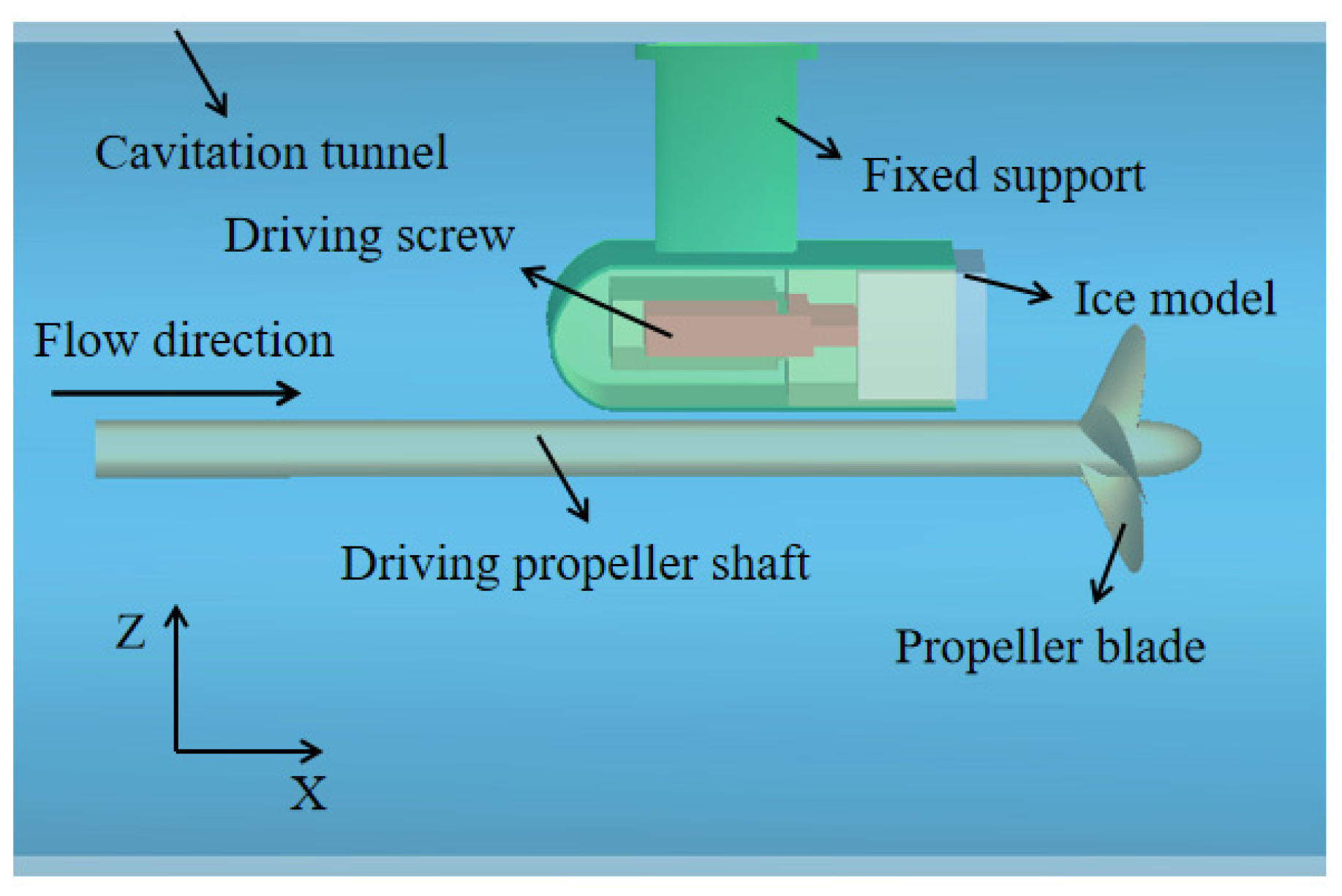

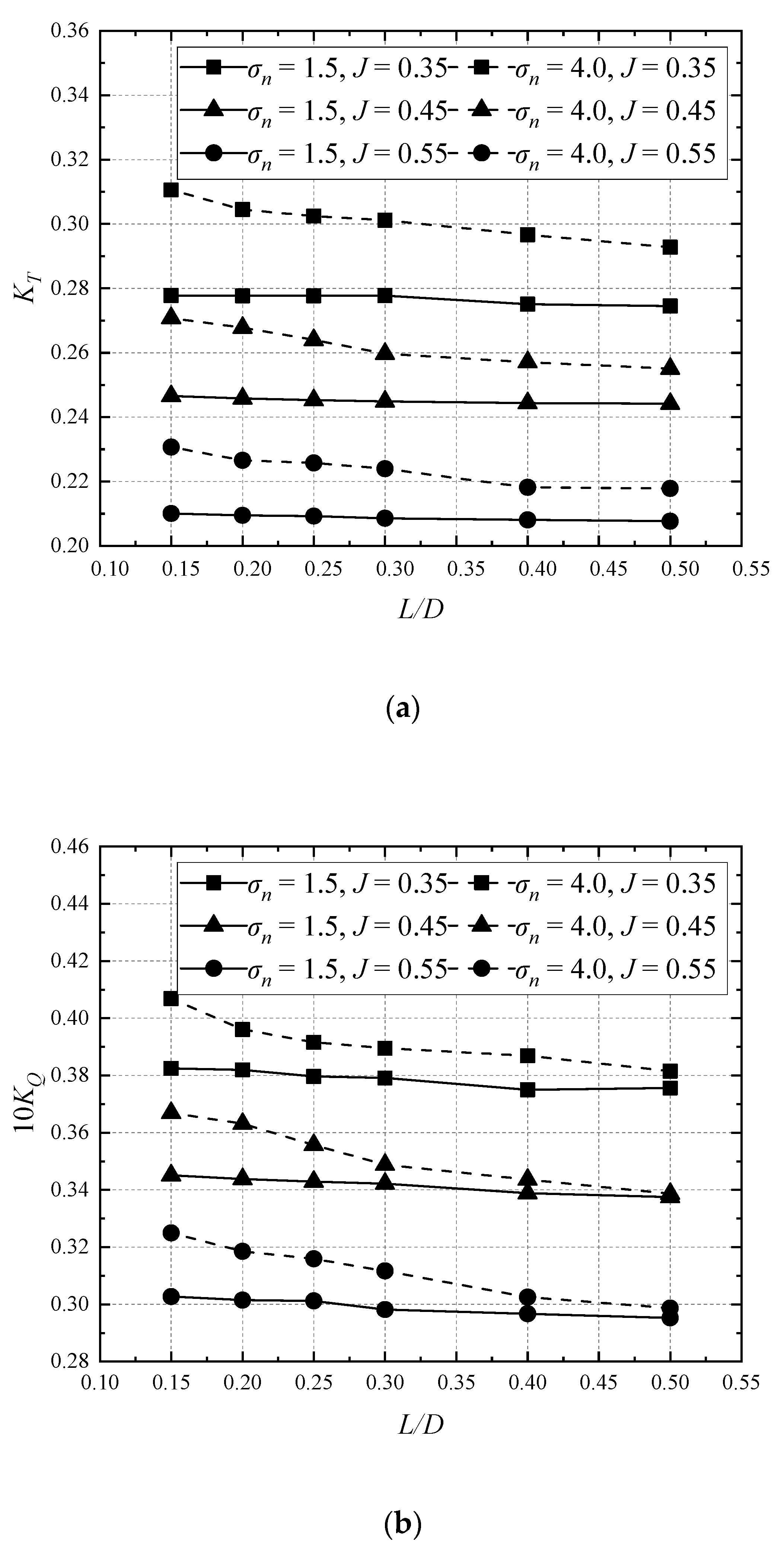
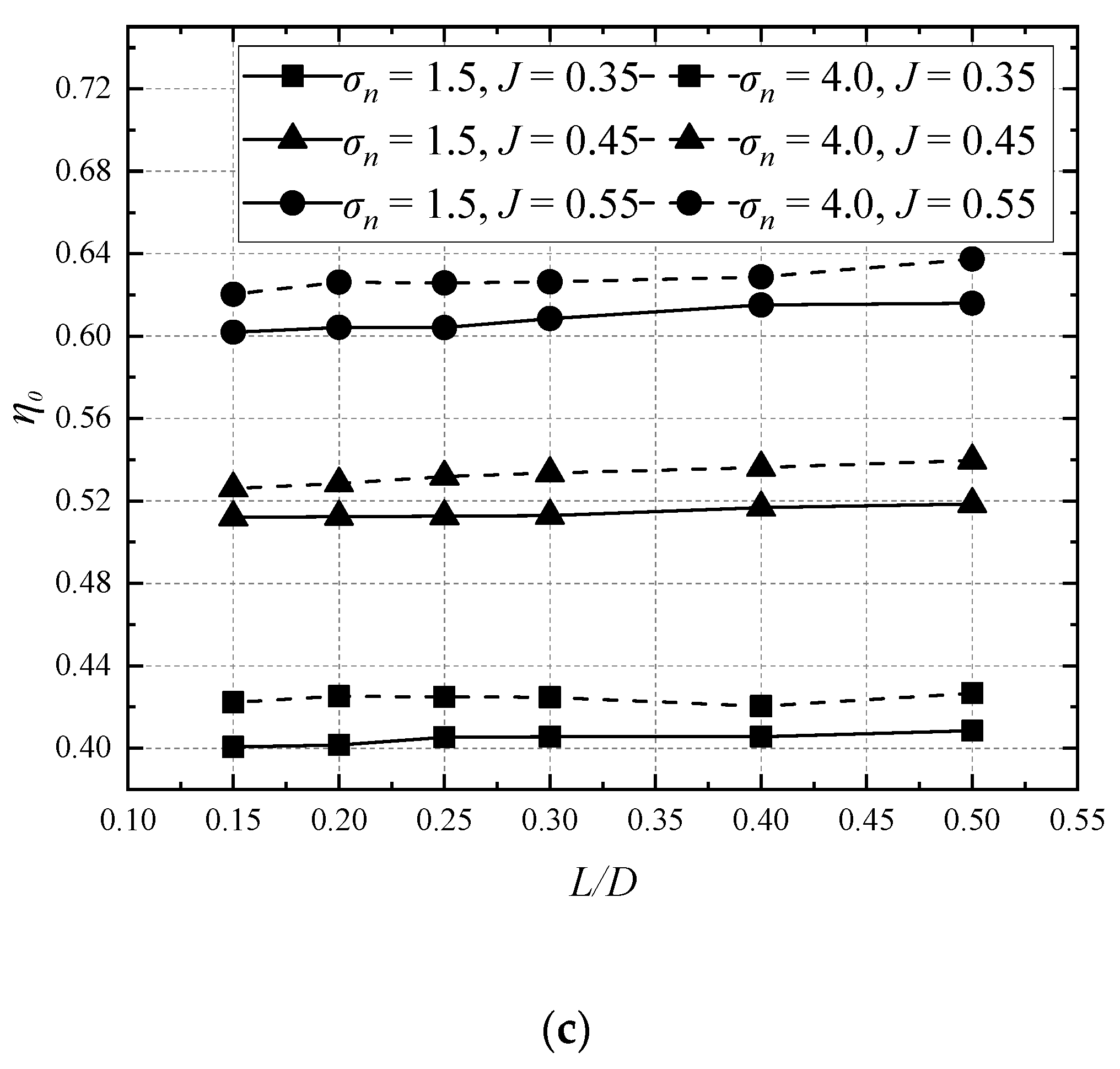
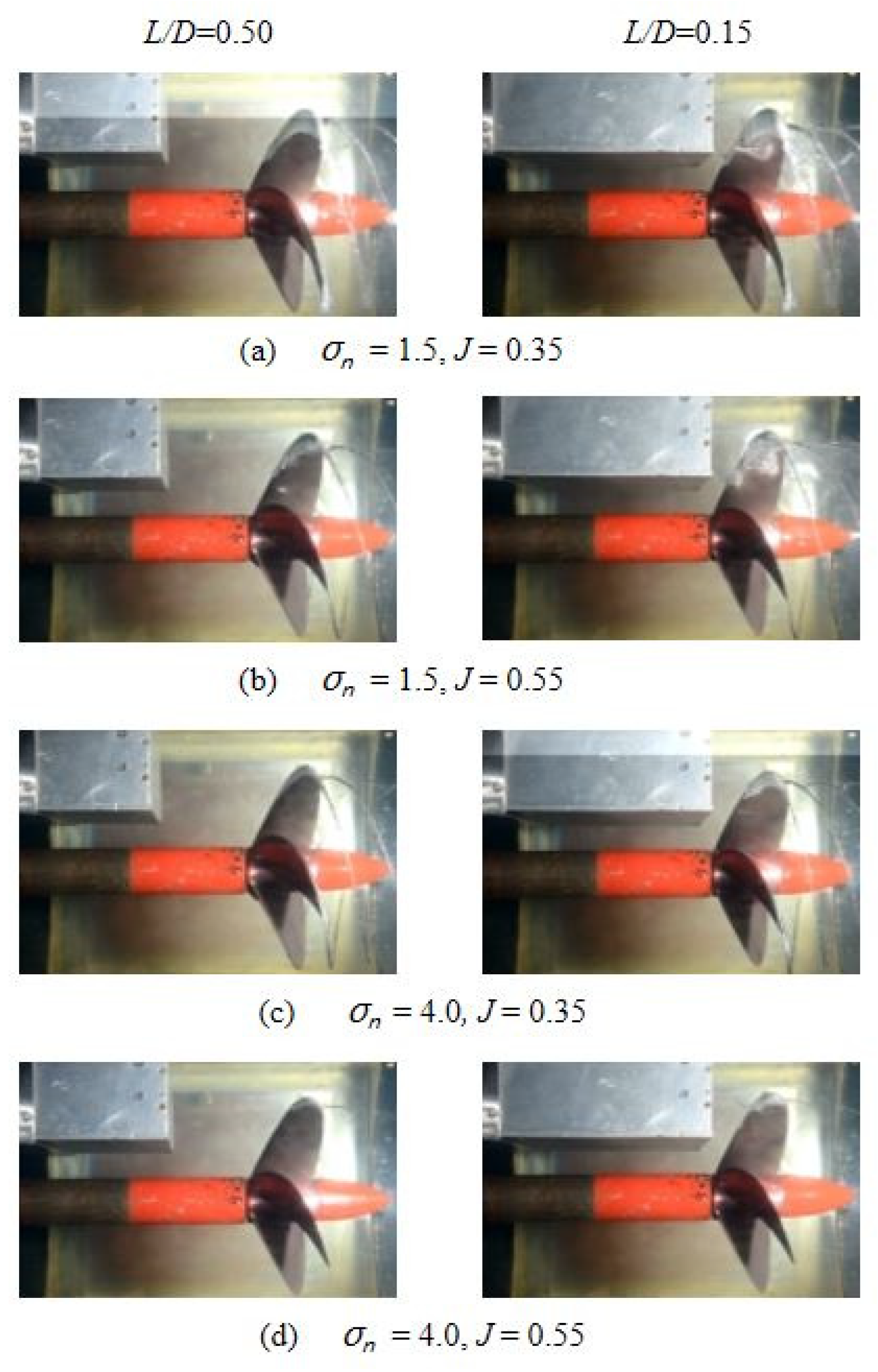
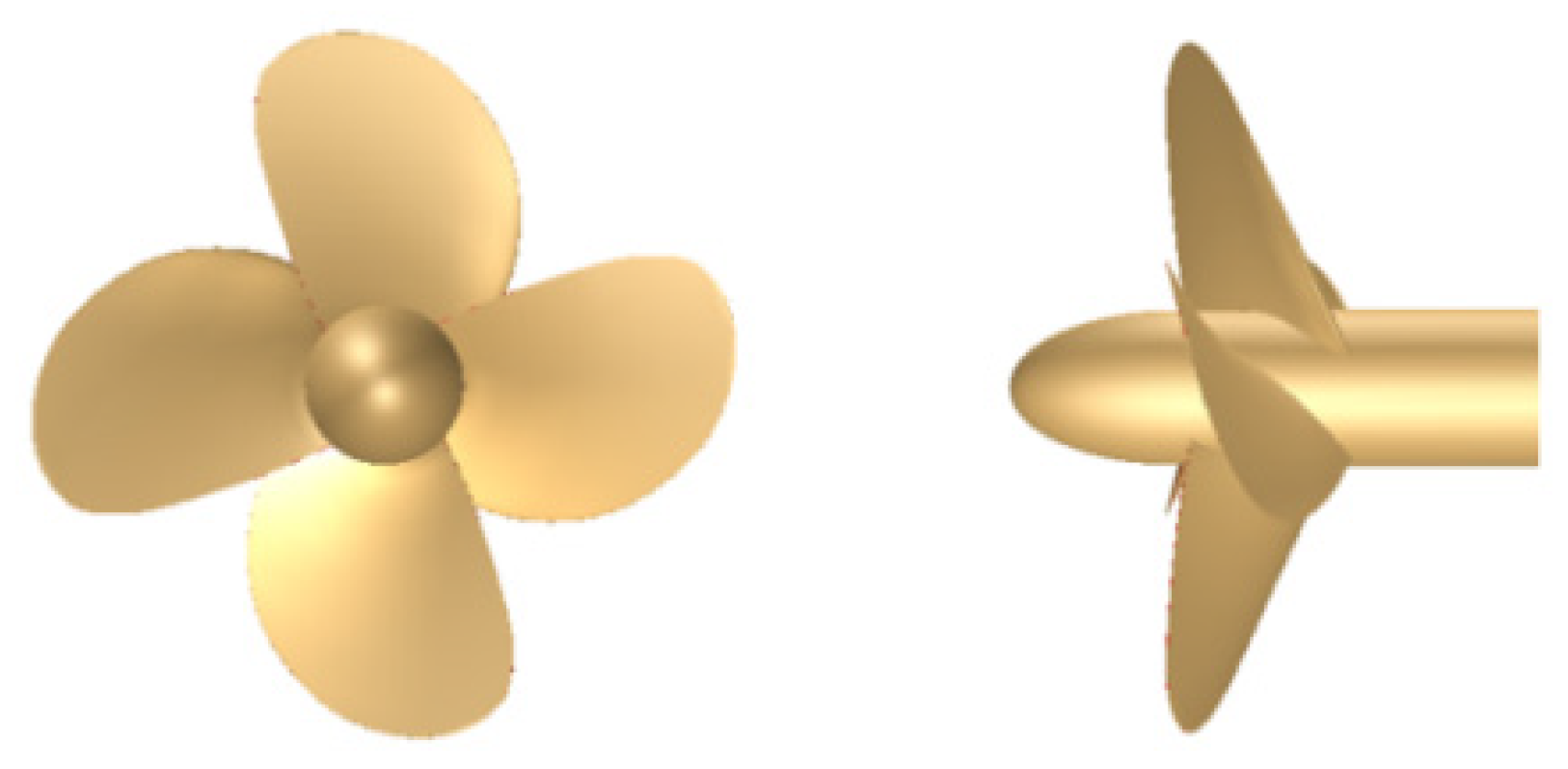



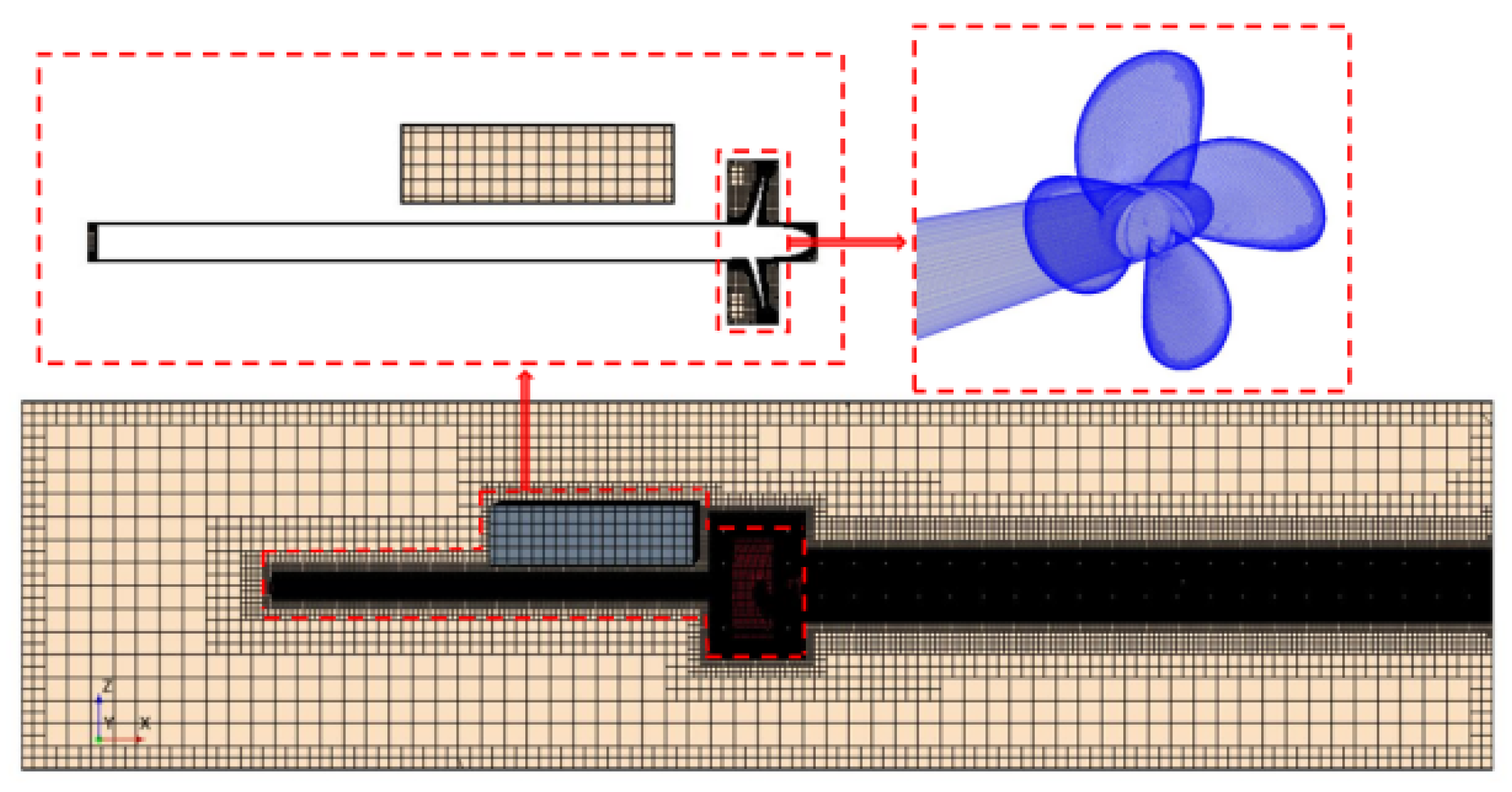
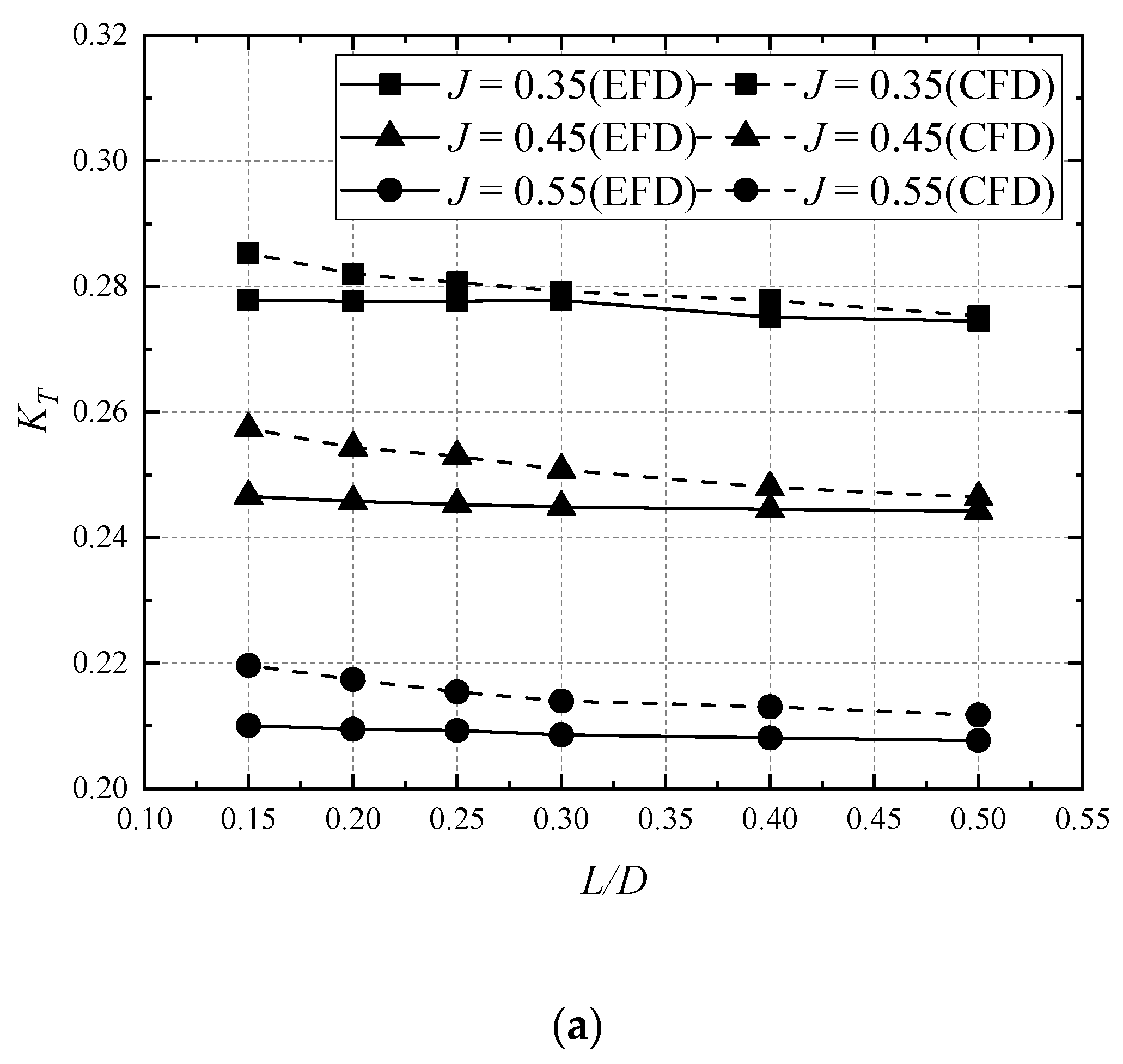
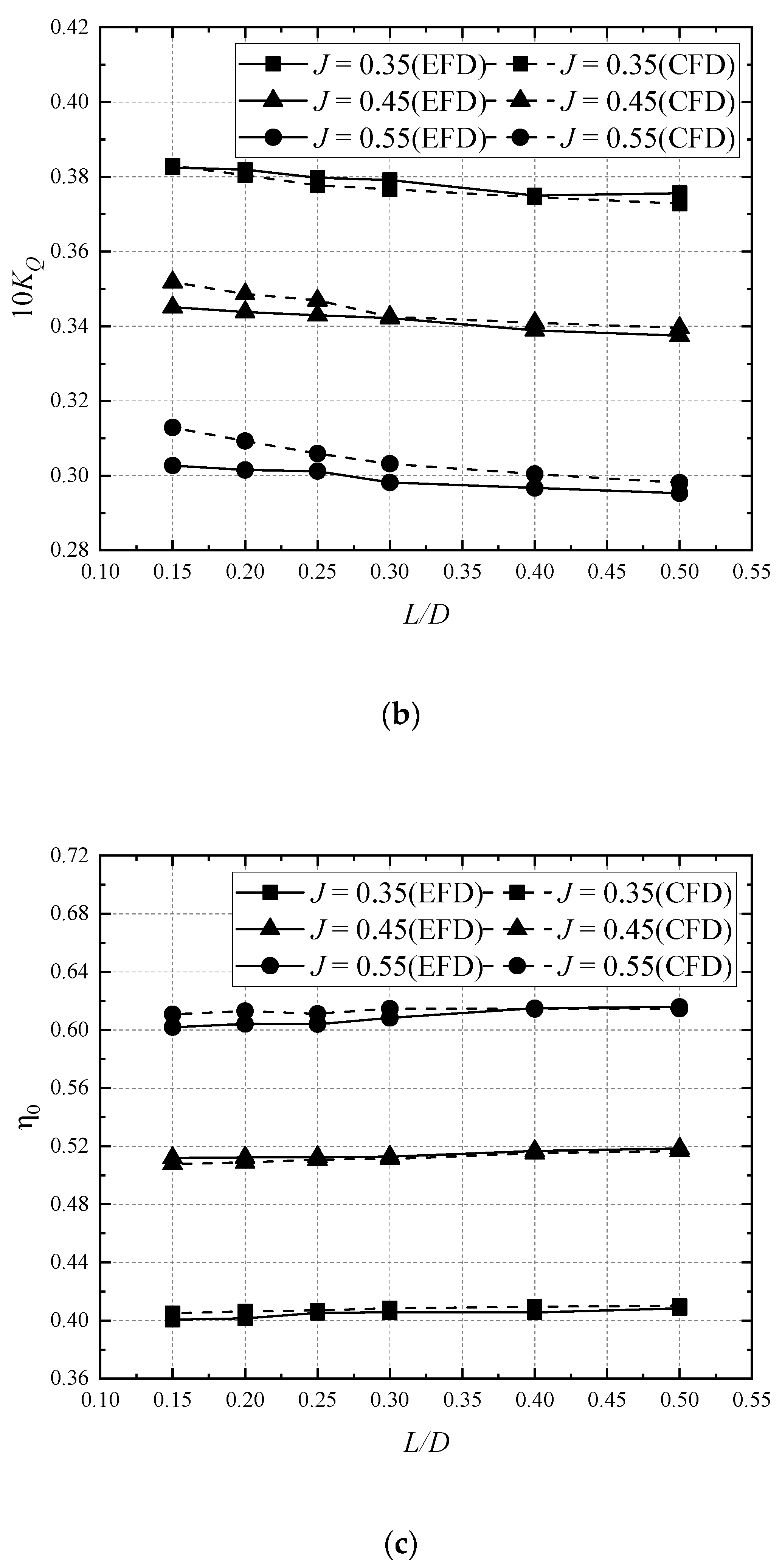
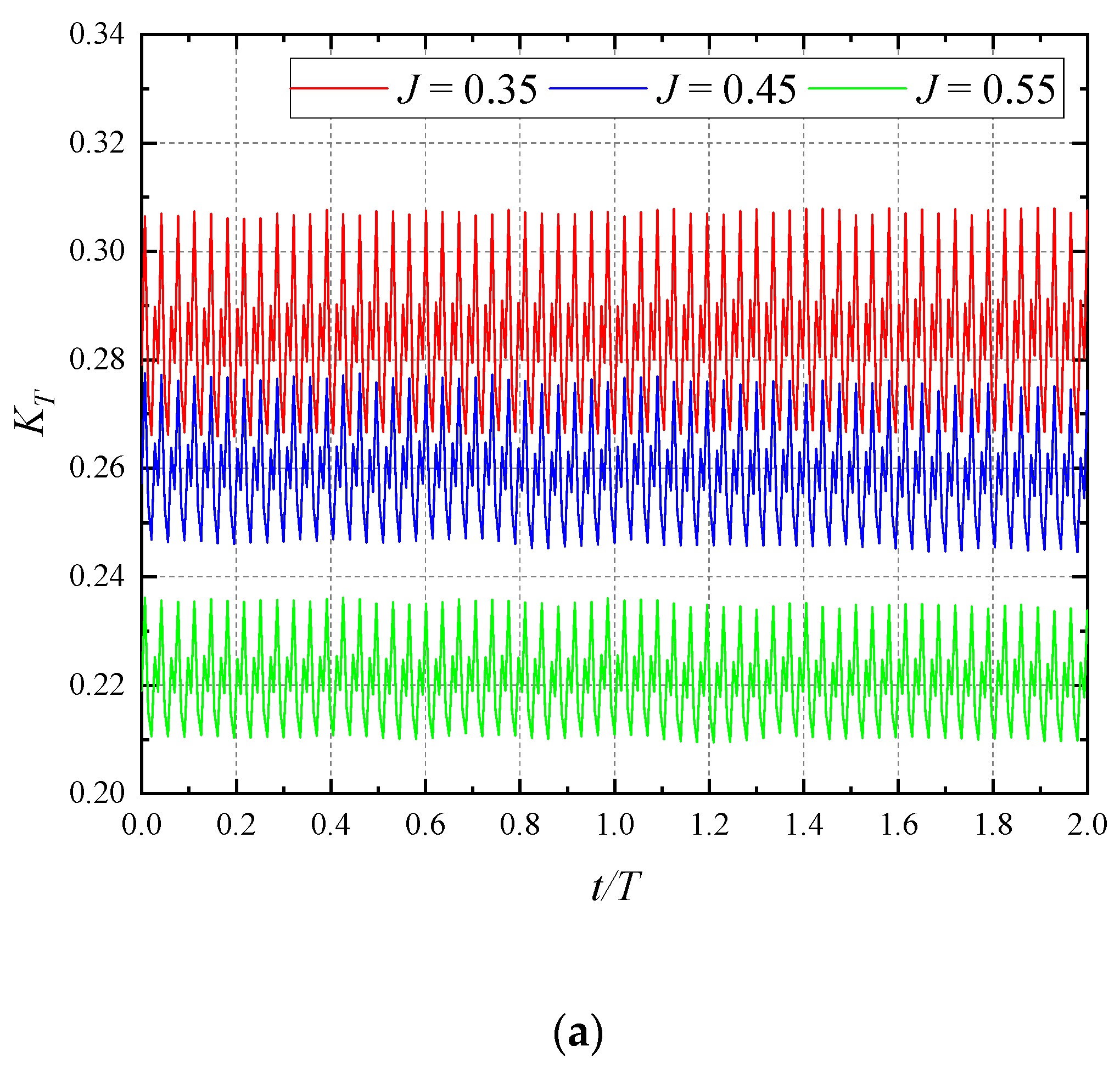




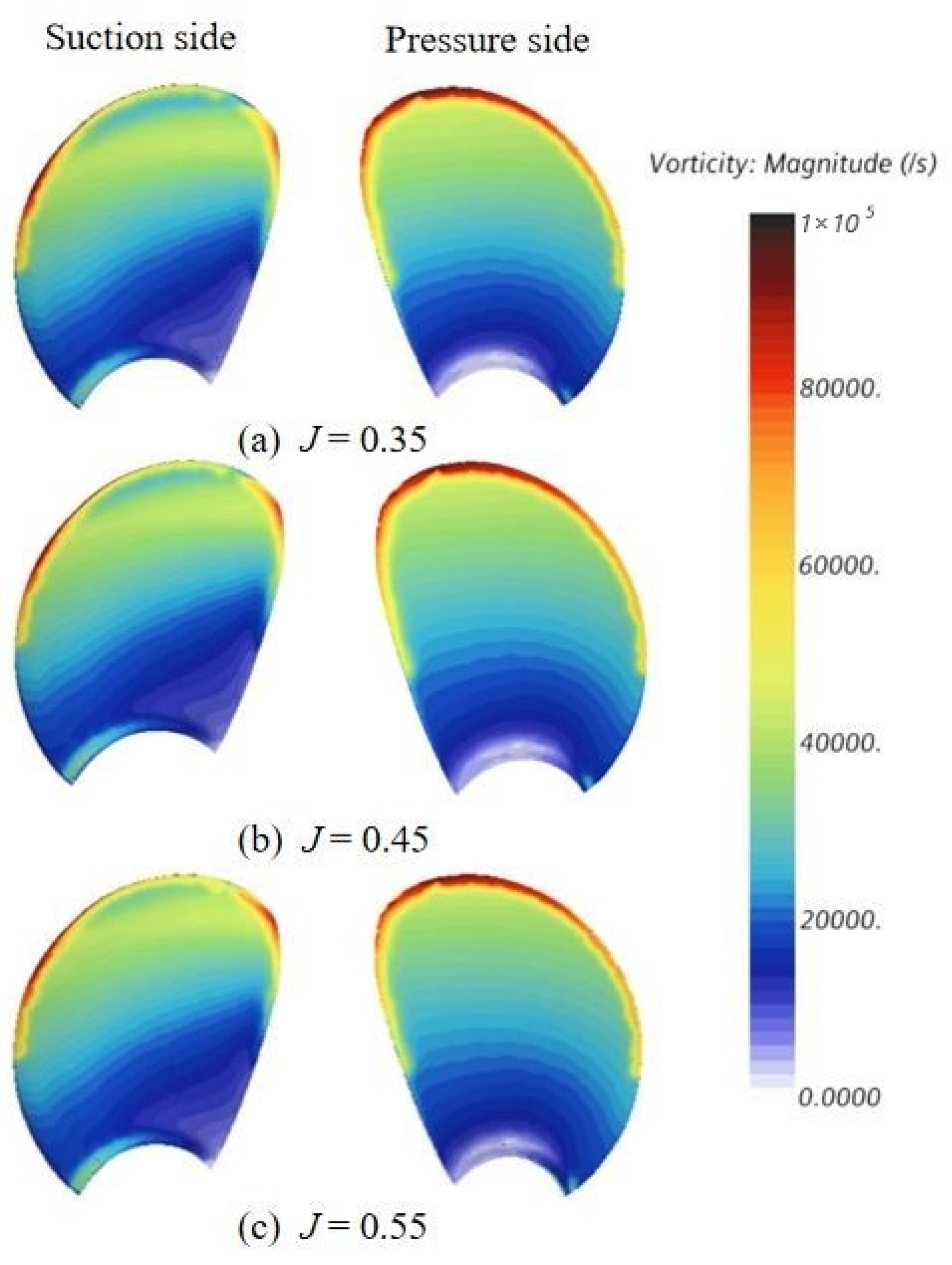
| Parameters | Full Scale | Model Scale |
|---|---|---|
| Scale ratio λ | 1 | 28 |
| Diameter D (m) | 7.0 | 0.25 |
| Number of Blades Z | 4 | 4 |
| Pitch/Diameter Ratio (P/D)0.7R | 0.84 | 0.84 |
| Blade area ratio AE/A0 | 0.75 | 0.75 |
| Hub Diameter Ratio dh/D | 0.21 | 0.21 |
| Instruments | Model Number | Parameters | Range |
|---|---|---|---|
| Pressure transmitter | 3151 | Pressure measurement | 0–0.3 MPa |
| Velocity measurement | 3–20 m/s | ||
| Rotating speed measuring instrument | FC4-490F | Rotating speed measurement | 0–4500 rpm |
| Long Axis dynamo meter | 1415 | Thrust Force | 0–3000 N |
| Torque | 0–150 N·m | ||
| Rotating speed | 0–3000 rpm |
| Operating Conditions | σn | J | L/D |
|---|---|---|---|
| 1 | 1.5 | 0.35 | 0.15, 0.20, 0.25, 0.30, 0.40, 0.50 |
| 2 | 0.45 | ||
| 3 | 0.55 | ||
| 4 | 4.0 | 0.35 | |
| 5 | 0.45 | ||
| 6 | 0.55 |
| Grids | J | KT | 10KQ | Error (%) | |
|---|---|---|---|---|---|
| KT | 10KQ | ||||
| Sliding grids | 0.4 | 0.1854 | 0.2678 | −1.827 | −0.750 |
| 0.5 | 0.1701 | 0.2538 | −2.702 | 0.191 | |
| 0.6 | 0.1237 | 0.2070 | −1.667 | 1.209 | |
| 0.7 | 0.0833 | 0.1603 | −1.828 | 1.989 | |
| 0.8 | 0.0348 | 0.1030 | −3.875 | 3.993 | |
| overlapping grids | 0.4 | 0.1886 | 0.2721 | −0.125 | 0.851 |
| 0.5 | 0.1740 | 0.2572 | −0.464 | 1.531 | |
| 0.6 | 0.1246 | 0.2067 | −1.734 | 1.058 | |
| 0.7 | 0.0826 | 0.1592 | −2.725 | 1.289 | |
| 0.8 | 0.0354 | 0.1006 | −2.291 | 1.613 | |
Publisher’s Note: MDPI stays neutral with regard to jurisdictional claims in published maps and institutional affiliations. |
© 2022 by the authors. Licensee MDPI, Basel, Switzerland. This article is an open access article distributed under the terms and conditions of the Creative Commons Attribution (CC BY) license (https://creativecommons.org/licenses/by/4.0/).
Share and Cite
Zhou, L.; Zheng, S.; Diao, F.; Ding, S.; Gao, J. Experimental and Numerical Study on Ice Blockage Performance of Propeller in Cavitation Flow. Water 2022, 14, 1060. https://doi.org/10.3390/w14071060
Zhou L, Zheng S, Diao F, Ding S, Gao J. Experimental and Numerical Study on Ice Blockage Performance of Propeller in Cavitation Flow. Water. 2022; 14(7):1060. https://doi.org/10.3390/w14071060
Chicago/Turabian StyleZhou, Li, Sijie Zheng, Feng Diao, Shifeng Ding, and Junliang Gao. 2022. "Experimental and Numerical Study on Ice Blockage Performance of Propeller in Cavitation Flow" Water 14, no. 7: 1060. https://doi.org/10.3390/w14071060
APA StyleZhou, L., Zheng, S., Diao, F., Ding, S., & Gao, J. (2022). Experimental and Numerical Study on Ice Blockage Performance of Propeller in Cavitation Flow. Water, 14(7), 1060. https://doi.org/10.3390/w14071060








